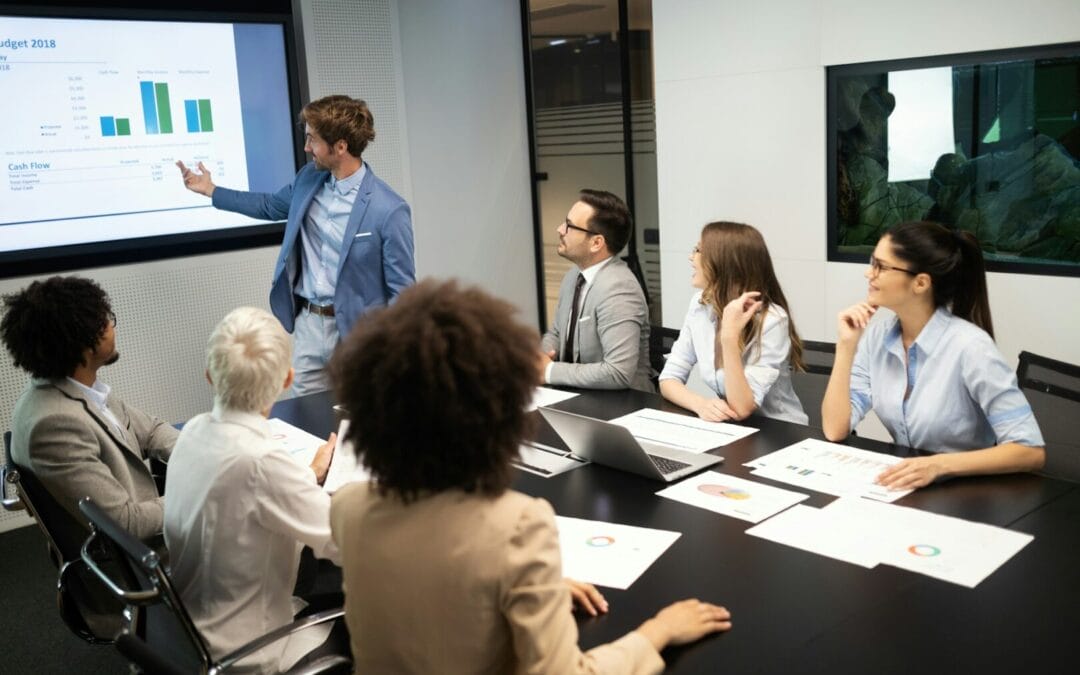Upgrading the technology in your conference room can make a big difference in how effectively your team communicates and collaborates. One of the best ways to achieve this is by incorporating projectors and workstations into your setup. These tools are essential for facilitating large Zoom meetings and delivering engaging training presentations.
Incorporating a high-quality projector into your conference room can help you display clear and detailed visuals during virtual meetings. This setup allows everyone in the room to see shared content easily, helping to keep the team engaged and on the same page. Workstations, on the other hand, provide a dedicated space for pulling up and sharing presentations seamlessly, improving both the flow and efficiency of your training sessions.
We always emphasize the importance of a well-designed conference room where audio and video equipment work harmoniously. Beyond just choosing the right projector or workstation, it’s crucial to integrate these elements properly to create a cohesive and effective environment. This holistic approach ensures that your conference room meets the diverse needs of your team, from virtual meetings to training sessions, fostering a better collaborative atmosphere overall.
Enhancing Collaboration with Projectors for Mass Zoom Meetings
Using projectors in conference rooms can significantly enhance collaboration during virtual meetings. Projectors can display content clearly and vividly on a large screen, making presentations more visible to all participants, whether they’re in the room or joining remotely. This technology helps maintain focus and engagement, as everyone can easily see the shared documents, slides, or videos. Additionally, projectors can facilitate interactive discussions by allowing easy transitions between different media types, such as spreadsheets, videos, and live annotations.
The benefits of using projectors for virtual meetings are numerous. Firstly, they enable a seamless transition from face-to-face discussions to digital presentations, making it easier to manage hybrid meetings. Projectors can also reduce eye strain for participants, as they provide a larger viewing area compared to individual monitors. Selecting the right projector involves considering factors such as resolution, brightness, and connectivity options. Evaluating the size of the conference room and the typical lighting conditions will guide the choice of a projector with the optimal lumens rating and screen size, ensuring that all participants benefit from clear, sharp images.
Leveraging Workstations for Effective Training Presentations
Workstations play a crucial role in the effectiveness of training presentations. In a conference room setting, a powerful workstation can manage demanding tasks such as running multiple applications, high-resolution videos, and dynamic presentations without lag. This capability becomes particularly important when the goal is to deliver engaging and interactive training sessions that keep participants involved and attentive.
When selecting a workstation, several key features should be considered. Look for powerful processors, ample RAM, and high-capacity SSDs to handle intensive workloads efficiently. Additionally, multiple connectivity options are essential, supporting various peripherals like external displays, projectors, and interactive whiteboards. Integrating workstations into an existing setup involves ensuring compatibility with the current AV equipment and networking infrastructure. Proper integration allows for a streamlined training environment where trainers can easily access and display training materials, thus enhancing the overall learning experience for participants.
Audio and Video Integration for Seamless Workflow
Integrating essential audio and video equipment into your conference room can significantly enhance workflow and productivity. High-quality microphones and speakers ensure clear communication during meetings, while high-definition cameras enable crisp visuals for all participants. For video, it’s beneficial to use cameras capable of auto-focus and wide-angle views, allowing everyone in the room to be seen clearly on the screen.
To optimize sound and video quality, consider the room’s acoustics and lighting. Installing sound-absorbing materials can reduce echoes and improve audio clarity. For video, position the cameras and screens to avoid glare and shadows, ensuring that the participants are always clearly visible. Additionally, using software solutions to adjust audio and video settings can help fine-tune the system for the best performance.
Best practices for setting up integrated systems involve ensuring that all components are compatible and seamlessly connected. Using a central control system can simplify the management of audio and video equipment, allowing for easy adjustments during meetings. Regularly updating firmware and software ensures that the system remains secure and performs optimally.
Electrical Considerations for Modern Conference Rooms
Proper electrical planning is crucial for designing modern conference rooms that support various technologies. Switched office outlets and networkable LED lighting provide flexibility and energy efficiency, allowing you to control lighting levels and power outlets remotely. This capability ensures that the room is always ready for different types of meetings and presentations, enhancing the overall user experience.
Implementing switched office outlets can prevent unnecessary energy consumption by turning off devices when they’re not in use. Networkable LED lighting offers customizable lighting schemes that can be adjusted based on the time of day or meeting requirements. These features are essential for creating a comfortable and productive environment.
Ensuring reliable power involves choosing the appropriate uninterruptible power supply (UPS) systems for your network. UPS systems protect your equipment from power surges and outages, preventing data loss and damage to sensitive devices. Selecting the right UPS involves considering the power requirements of all your devices and ensuring that the system can support them for an extended period. This step is critical for maintaining uninterrupted operations and safeguarding your technology investments.
Conclusion
Setting up a modern conference room involves careful consideration of audio, video, and electrical elements to create a space that supports seamless collaboration and productivity. From enhancing video quality with projectors to selecting the right workstation for training sessions, each component plays a vital role in optimizing the conference room experience. Proper integration of essential equipment and robust electrical planning ensures that your setup is efficient and reliable.
At Basile Consulting, we specialize in crafting tailored conference room setups that meet your specific needs. If you’re ready to transform your conference room into a high-performance collaborative space, reach out to us today. Let’s create the perfect environment for your team to thrive.


